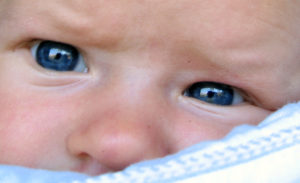The color of a newborn’s skin changes as the days go by. At birth, many parents end up surprised, as the baby’s skin tone is usually different from what it will be later in life. This happens because a newborn’s skin is very sensitive and changes with each situation, such as when they cry, sleep, or due to room temperature. However, over the days, it stabilizes and begins to take on its permanent color.
Why Does a Newborn’s Skin Color Change?
At birth, most babies, regardless of race, are to some extent purplish and reddish. Babies born through vaginal delivery are usually more purplish due to the strain of passing through the birth canal. However, this usually normalizes a few hours later. Babies born by cesarean are more reddish, as they did not go through this physical effort.  After a day or two, the purple color becomes pinker, due to visible blood vessels through the very thin skin of the newborn. At this stage, the newborn’s skin color changes—some take on a yellowish hue due to physiological jaundice; this is very common in newborn babies1. A newborn’s feet may remain purple for a while due to immature blood circulation. But in the end, the newborn’s skin color changes because it is controlled by genes, and there’s nothing we can do to control it.
After a day or two, the purple color becomes pinker, due to visible blood vessels through the very thin skin of the newborn. At this stage, the newborn’s skin color changes—some take on a yellowish hue due to physiological jaundice; this is very common in newborn babies1. A newborn’s feet may remain purple for a while due to immature blood circulation. But in the end, the newborn’s skin color changes because it is controlled by genes, and there’s nothing we can do to control it.
But What Does This Mean?
Over the next six months, a newborn’s skin color changes and the baby’s true skin color develops, regardless of what it looked like at birth. It is common to hear parents of African descent share that their babies were born light-skinned or pinkish, and then darkened by one to three shades over the following months to a color equal to or close to theirs. What happens is that as the baby grows, the amount of melanin increases (the pigment responsible for skin color, which appears according to inherited traits without sun exposure). This melanin comes from a combination of the parents’ genes as well as ancestry, meaning skin color is an example of polygenic inheritance. This means that multiple genes collectively influence phenotypic traits2. In fact, there are several different genes that regulate a range of melanin production processes. So, no matter what color a baby is born, the newborn’s skin color changes, or will change, over time.
How Does This Change Happen?
If the explanation above is still not clear, think of it differently. As a strange analogy, imagine a room with several light switches controlling different sets and numbers of lights. When all the switches are off, the room is dark. When all the switches are on, the room is bright. When some switches are on and others off, the room is partially lit, and you can alter how light or dark it is depending on which switch you choose to keep on or off. Different skin colors are shown in a similar way, because various genes are expressed in different ways. It’s an imperfect example, but it helps to show that the inheritance of skin color is more complex than it seems.
What About the Baby’s Eye Color? Does It Change?
Just as a newborn’s skin color changes, so does their eye color. When they are born, especially fair-skinned babies, they have bluish, greenish, or grayish eyes because there is little melanin in them. The amount of melanin in the iris, the colored part of the eye, is what determines a person’s eye color. Genetics controls the amount of melanin (or pigment) a person will have in their body.  The DNA that the baby receives from the mother and her partner determines if their eyes will be blue, brown, green, or another color3. A baby can be born with blue eyes (because while the baby is in the womb, the eyes do not produce, or sometimes produce only a very small amount of melanin), but after birth, light stimulates melanin production, which is why eye color can darken or change over time. It is important to understand that it is not the color of the pigment that causes the eye color change. There is no blue, gray, green, or hazel pigment in the eyes. The only pigment in the eye is brown, and the amount of this pigment determines whether a person’s eyes are light or dark. Usually the biggest change happens in the first 6 to 9 months of life. Over a few weeks or months, you’ll notice the baby’s eyes becoming darker. The change is so gradual that many parents do not notice, until one day the baby wakes up and surprises them with a different eye color. In 12 months, most babies will have their permanent eye color. So don’t worry about your baby’s skin; know that a newborn’s skin color changes, but your love for them does not. So enjoy this moment! Also See: Strabismus in Babies – Is There a Cure? Photos: Pixabay, torbakhopper
The DNA that the baby receives from the mother and her partner determines if their eyes will be blue, brown, green, or another color3. A baby can be born with blue eyes (because while the baby is in the womb, the eyes do not produce, or sometimes produce only a very small amount of melanin), but after birth, light stimulates melanin production, which is why eye color can darken or change over time. It is important to understand that it is not the color of the pigment that causes the eye color change. There is no blue, gray, green, or hazel pigment in the eyes. The only pigment in the eye is brown, and the amount of this pigment determines whether a person’s eyes are light or dark. Usually the biggest change happens in the first 6 to 9 months of life. Over a few weeks or months, you’ll notice the baby’s eyes becoming darker. The change is so gradual that many parents do not notice, until one day the baby wakes up and surprises them with a different eye color. In 12 months, most babies will have their permanent eye color. So don’t worry about your baby’s skin; know that a newborn’s skin color changes, but your love for them does not. So enjoy this moment! Also See: Strabismus in Babies – Is There a Cure? Photos: Pixabay, torbakhopper











